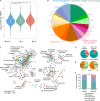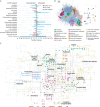Transcriptional landscape of the cell cycle in a model thermoacidophilic archaeon reveals similarities to eukaryotes
- PMID: 40593522
- PMCID: PMC12216602
- DOI: 10.1038/s41467-025-60613-8
Transcriptional landscape of the cell cycle in a model thermoacidophilic archaeon reveals similarities to eukaryotes
Abstract
Similar to many eukaryotes, the thermoacidophilic archaeon Saccharolobus islandicus follows a defined cell cycle program, with two growth phases, G1 and G2, interspersed by a chromosome replication phase (S), and followed by genome segregation and cytokinesis (M-D) phases. To study whether and which other processes are cell cycle-coordinated, we synchronized cultures of S. islandicus and performed an in-depth transcriptomic analysis of samples enriched in cells undergoing the M-G1, S, and G2 phases, providing a holistic view of the S. islandicus cell cycle. We show that diverse metabolic pathways, protein synthesis, cell motility and even antiviral defense systems, are expressed in a cell cycle-dependent fashion. Moreover, application of a transcriptome deconvolution method defined sets of phase-specific signature genes, whose peaks of expression roughly matched those of yeast homologs. Collectively, our data elucidates the complexity of the S. islandicus cell cycle, suggesting that it more closely resembles the cell cycle of certain eukaryotes than previously appreciated.
© 2025. The Author(s).
Conflict of interest statement
Competing interests: The authors declare no competing interests.
Figures






Similar articles
-
Gene expression and co-expression heterogeneity patterns and biodemography analyses during the cell cycle encourage aging studies in archaea.Geroscience. 2025 Jul 5. doi: 10.1007/s11357-025-01769-5. Online ahead of print. Geroscience. 2025. PMID: 40615640
-
Deciphering Shared Gene Signatures and Immune Infiltration Characteristics Between Gestational Diabetes Mellitus and Preeclampsia by Integrated Bioinformatics Analysis and Machine Learning.Reprod Sci. 2025 Jun;32(6):1886-1904. doi: 10.1007/s43032-025-01847-1. Epub 2025 May 15. Reprod Sci. 2025. PMID: 40374866
-
Integrated proteotranscriptomics of breast cancer reveals globally increased protein-mRNA concordance associated with subtypes and survival.Genome Med. 2018 Dec 3;10(1):94. doi: 10.1186/s13073-018-0602-x. Genome Med. 2018. PMID: 30501643 Free PMC article.
-
Maternal and neonatal outcomes of elective induction of labor.Evid Rep Technol Assess (Full Rep). 2009 Mar;(176):1-257. Evid Rep Technol Assess (Full Rep). 2009. PMID: 19408970 Free PMC article.
-
Antidepressants for pain management in adults with chronic pain: a network meta-analysis.Health Technol Assess. 2024 Oct;28(62):1-155. doi: 10.3310/MKRT2948. Health Technol Assess. 2024. PMID: 39367772 Free PMC article.
Cited by
-
Coupling chromosome organization to genome segregation in Archaea.Nat Commun. 2025 Jul 22;16(1):6759. doi: 10.1038/s41467-025-61997-3. Nat Commun. 2025. PMID: 40695815 Free PMC article.
References
MeSH terms
Grants and funding
LinkOut - more resources
Full Text Sources

